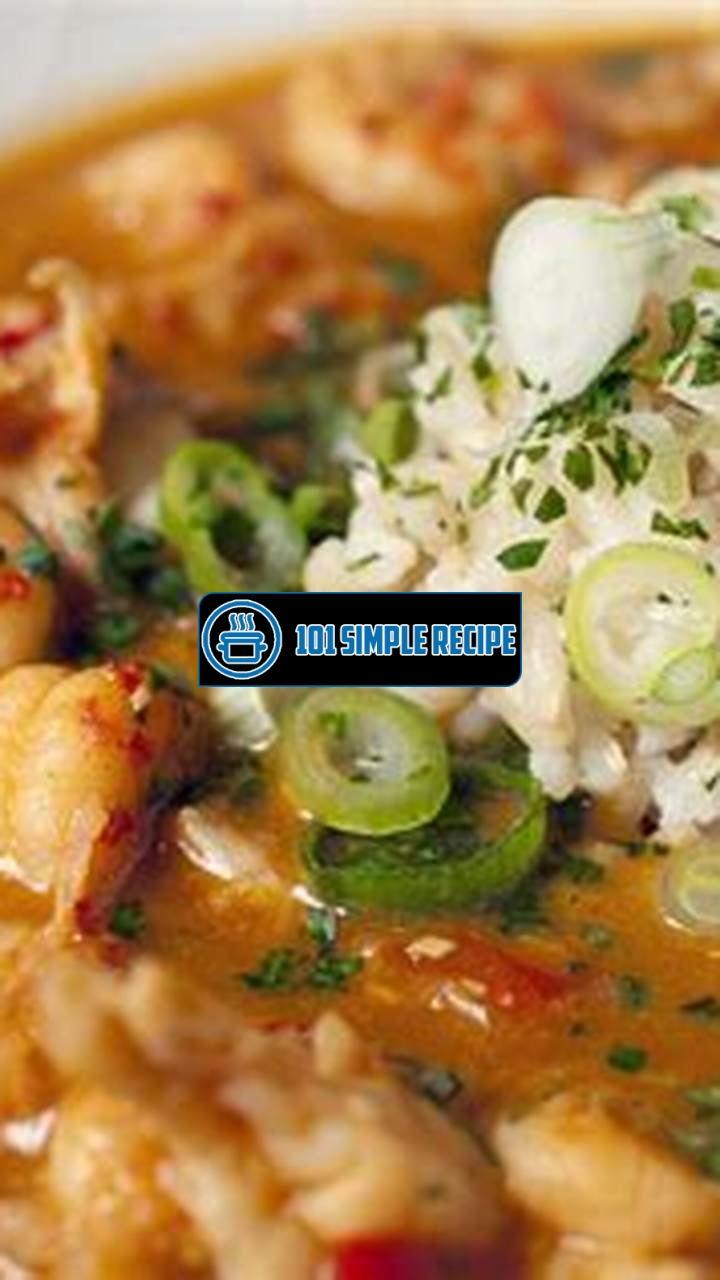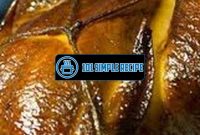Savor the authentic taste of Cajun Etouffee and indulge in a culinary journey that will transport your taste buds to the vibrant streets of Louisiana. ️ This iconic Cajun dish is a true testament to the rich cultural heritage and flavorsome traditions that have made it a beloved favorite all around the world. Etouffee, which translates to “smothered” in French, perfectly encapsulates the essence of comfort food with its hearty combination of tender seafood, aromatic spices, and a velvety roux-based sauce. Each bite of this delectable dish is a harmonious blend of flavors, leaving you craving for more. So get ready to embark on a gastronomic adventure as we dive into the captivating world of Cajun Etouffee. ️✨

Introduction to Cajun Etouffee Recipe
Get ready to tantalize your taste buds with the rich and flavorful world of Cajun cuisine! In this comprehensive guide, we will walk you through the intricate art of crafting the perfect Cajun etouffee. This classic Louisiana dish is a true masterpiece that combines French and Southern flavors to create a savory delight that will transport you straight to the heart of the Bayou.
Before we dive into the history and origins of Cajun etouffee, let’s take a moment to appreciate the magic that this dish brings to the table. ️ Picture yourself savoring each bite of velvety-smooth sauce, generously coating succulent shrimp or crawfish, and served over a bed of fluffy rice. The exquisite blend of spices, aromatic vegetables, and luscious seafood creates a culinary experience that’s simply irresistible.
History and Origins of Cajun Etouffee
Unraveling the origins of Cajun etouffee: This beloved dish has deep roots in the vibrant Cajun culture of Louisiana. Etouffee, which translates to “smothered” in French, reflects the cooking style of the Acadian people who settled in the region. Born out of necessity, etouffee was a clever way to use leftover seafood and transform it into a hearty meal. Over time, it evolved into a cherished delicacy that holds a special place in Cajun cuisine.
A blend of cultures: Cajun cuisine itself is a harmonious blend of French, African, Caribbean, and Native American influences. This unique fusion of flavors and techniques is what sets Cajun etouffee apart from other dishes. The use of aromatic vegetables like onions, bell peppers, and celery, along with a medley of spices, adds depth and complexity to the dish, making each bite a savory delight.
⚜️ A symbol of Cajun pride: Cajun etouffee not only represents the culinary traditions of Louisiana but also embodies the resilience and resourcefulness of the Cajun people. It has become an iconic symbol of their heritage and a testament to their vibrant culture. As you savor this dish, you become a part of this rich history and keep the Cajun spirit alive.
The Key Ingredients of Cajun Etouffee
Fresh seafood: The star of Cajun etouffee is undoubtedly the seafood. Whether you choose succulent shrimp or tender crawfish, make sure it’s fresh to enhance the overall flavor of the dish. The delicate sweetness of the seafood balances perfectly with the robust Cajun spices.
️ Aromatic vegetables: Onions, bell peppers, and celery form the flavorful base of Cajun etouffee. These “holy trinity” vegetables add depth and fragrance to the dish, creating a tantalizing aroma that will have your taste buds dancing with delight.
Spices and herbs: The Cajun spice blend is what gives etouffee its distinct kick. A combination of paprika, cayenne pepper, thyme, and oregano adds a fiery yet balanced flavor to the dish. Make sure to adjust the spice level according to your preference!
Accompaniments: To complete the Cajun etouffee experience, serve it over a bed of fluffy white rice. The rice acts as a neutral canvas, allowing the vibrant flavors of the etouffee to shine through.
Preparing the Roux
Master the art of creating a dark and flavorful roux, the foundation of any Cajun etouffee.
The Role of Roux in Cajun Cuisine
Roux is a fundamental ingredient in Cajun cuisine, playing a crucial role in adding depth and flavor to traditional dishes like etouffee. Roux is a thickening agent made by cooking equal parts fat and flour together. It serves as the base for many Cajun dishes and is responsible for their distinct richness and velvety texture.
By cooking the roux to different stages of darkness, you can achieve different flavors and colors in your final dish. The darker the roux, the more intense the flavors become. In Cajun cooking, the roux is typically cooked until it reaches a deep brown color, giving the etouffee its caramel-like taste.
Without a well-prepared roux, your etouffee may lack the authentic Cajun taste that it is known for. So, it’s essential to perfect the art of making a flavorful roux to truly savor the authentic taste of Cajun etouffee.
Choosing and Cooking the Right Fats for the Roux
The choice of fat used in the roux greatly influences its flavor and consistency. Traditionally, Cajun cuisine relies on animal fats like butter, bacon grease, or lard to create the roux. These fats add a rich and savory taste that complements the other ingredients in the dish.
However, if you prefer a lighter option, you can use vegetable oils like canola or grapeseed oil. These oils still provide the necessary fat content for the roux while allowing the flavors of the other ingredients to shine through.
To cook the roux, heat the chosen fat in a heavy-bottomed skillet or pot over medium heat. Gradually add the flour, stirring constantly to ensure it blends smoothly with the fat. Continue stirring and cooking until the roux reaches the desired color, making sure not to burn it.
The Perfect Consistency: Achieving the Ideal Roux Color
Knowing when the roux has reached the perfect consistency can be a challenge for beginners. The ideal roux color for Cajun etouffee is dark brown, resembling the color of chocolate or caramel.
Start by cooking the roux over medium heat, stirring constantly to prevent any burning. As it cooks, the roux will go through various stages of color and flavor. The key is to be patient and watchful, as rushing the process can result in a burnt or bitter taste.
When the roux reaches a rich brown color with a nutty aroma, it is ready to be incorporated into your etouffee. Remember, the darker the roux, the more robust and complex the flavors will be in the final dish.
Mastering the art of preparing the roux is an essential step in creating an authentic Cajun etouffee. The combination of the right fats, proper cooking techniques, and achieving the ideal roux color will elevate your dish to a whole new level of flavor. So, roll up your sleeves, gather your ingredients, and embark on a culinary journey to savor the authentic taste of Cajun etouffee!
Looking for more delicious recipes? Check out our Cajun gumbo recipe for a taste of Louisiana!
Choosing the Protein
When it comes to creating a delicious Cajun etouffee, choosing the right protein is essential. The protein you select will not only add depth and texture to your dish but also play a significant role in enhancing its overall flavor. There are various protein options available that can complement the rich and robust flavors of Cajun cuisine. Let’s explore some of the best choices that will take your etouffee to the next level.
Traditional vs. Creative Protein Choices
In traditional Cajun etouffee, the protein of choice is usually shellfish, such as crawfish or shrimp. These tender and succulent seafood options perfectly marry with the flavorful sauce, creating a harmonious blend of tastes. However, if you’re feeling a bit adventurous, you can experiment with other protein sources, such as chicken, sausage, or even tofu. These unconventional choices can add a unique twist to your etouffee without compromising its authentic Cajun essence.
Crawfish and shrimp are the go-to proteins for traditional Cajun etouffee, offering a classic taste. But don’t be afraid to mix it up and try chicken, sausage, or tofu for a creative twist.
Preparing and Seasoning the Protein
Once you’ve chosen your preferred protein, it’s important to prepare and season it properly. For shellfish like crawfish or shrimp, make sure to clean and devein them before cooking. This ensures that you remove any unwanted grit or impurities. To enhance the flavor, season the protein with a blend of Cajun spices, including paprika, cayenne pepper, garlic powder, and thyme. This combination will infuse the protein with a bold and zesty taste that perfectly complements the etouffee sauce.
Properly clean and devein shellfish like crawfish and shrimp before seasoning them with a flavorful blend of Cajun spices for a delectable taste explosion in your etouffee.
Adding the Protein to the Etouffee
Adding the protein to the etouffee is the final step in creating this mouthwatering dish. To achieve the perfect balance of flavors, it’s important to add the protein at the right moment. For shellfish, such as crawfish or shrimp, it’s best to cook them separately and then incorporate them into the etouffee during the final stages of cooking. This ensures that the protein remains tender and juicy, enhancing the overall texture of the dish.
Cook shellfish separately and add them to the etouffee towards the end of the cooking process to maintain their tenderness and preserve the authentic Cajun flavors.
Whether you choose a traditional protein like crawfish or shrimp or opt for a more creative option like chicken or sausage, selecting the right protein and preparing it with care will elevate the taste of your Cajun etouffee. Remember to clean, season, and add the protein at the appropriate time for a dish that bursts with authentic Cajun flavors and leaves you wanting more.
Craving some spicy flavor? Try our Cajun seasoning recipe to add some heat to your dishes!
Mastering the Flavor Profile
In order to create the authentic taste of Cajun etouffee, it is essential to master the flavor profile. This traditional Louisiana dish is known for its rich, robust flavors and complex spice blends. By understanding the key elements of Cajun cuisine, you can create a harmonious blend of spices and seasonings that will elevate your etouffee to new heights.
Must-Have Cajun Spices and Seasonings
When it comes to Cajun cooking, there are a few spices and seasonings that are absolute must-haves. These ingredients add depth, heat, and complexity to your etouffee. Here are some essential Cajun spices and seasonings:
- Paprika: A staple in Cajun cuisine, paprika adds a mild sweetness and vibrant red color to your etouffee.
- Cayenne Pepper: For those who enjoy a little heat, cayenne pepper is a must. Use it sparingly to add a kick to your dish.
- Garlic Powder: Garlic powder brings a distinctive flavor to Cajun etouffee. Its aromatic, savory taste is essential in building the depth of flavor.
- Onion Powder: The subtle sweetness and oniony flavor of onion powder complement the other spices in your etouffee, creating a well-rounded dish.
- Thyme: Thyme is a versatile herb that adds earthiness and depth to your Cajun etouffee. Its floral and slightly minty flavor is a key component of the traditional flavor profile.
- Oregano: Oregano adds a slightly bitter and pungent flavor to your etouffee. Its strong taste helps to balance the other spices and bring out the rich flavors of the dish.
Balancing Heat and Flavor
When it comes to Cajun cuisine, finding the right balance between heat and flavor is crucial. While Cajun etouffee is known for its spicy kick, it is important to ensure that the heat doesn’t overpower the other flavors in the dish. To achieve this, start with small amounts of cayenne pepper and gradually increase it to your desired level of spiciness. Taste as you go and adjust accordingly. Remember, the goal is to enhance the flavor of the dish, not overwhelm it with heat.
Enhancing the Depth of Flavor with Herbs and Aromatics
In addition to spices and seasonings, herbs and aromatics play a vital role in enhancing the depth of flavor in Cajun etouffee. Some key herbs and aromatics commonly used in this dish include:
- Celery: Celery adds a subtle, vegetal flavor to your etouffee. It also helps to add texture and freshness to the dish.
- Bell Peppers: Bell peppers contribute a vibrant, slightly sweet taste to Cajun etouffee. They also add color and texture to the dish.
- Green Onions: Green onions, also known as scallions, provide a mild onion flavor to your etouffee. They add a pleasant, slightly sharp taste to the dish.
- Parsley: Parsley adds a bright, fresh flavor to Cajun etouffee. Its herbaceous taste balances out the richness of the dish.
By incorporating these herbs and aromatics into your etouffee, you can elevate the flavors and create a more complex and satisfying dish.
Note: Experimenting with different spice blends and ingredient combinations is encouraged in Cajun cooking. Don’t be afraid to get creative and adjust the flavors according to your own preferences.
With these tips and a solid understanding of Cajun flavors, you are now ready to create a delicious and authentic Cajun etouffee. Remember, the key to mastering the flavor profile lies in finding the perfect balance of spices, seasonings, herbs, and aromatics. So, get in the kitchen and savor the incredible taste of Cajun cuisine!
Perfecting the Texture
In order to create a truly authentic and delicious Cajun etouffee, it is crucial to perfect the texture of this classic dish. The right consistency can elevate the flavors and make your etouffee a standout dish. Here are some techniques to help you achieve the ideal texture in your Cajun etouffee.
The Role of Liquid in Etouffee
The amount and type of liquid you use in your etouffee play a significant role in determining its texture. The liquid helps to create a rich and flavorful base for the dish. Traditionally, seafood stock or a combination of stock and water is used to simmer the etouffee.
It is important to add the liquid gradually and in increments, allowing it to be absorbed by the ingredients and thicken the sauce. This helps to create a thick and velvety texture that coats the other ingredients beautifully.
Thickening Agents and Their Proper Usage
To achieve the perfect thickness in your etouffee, you can employ the use of various thickening agents. The most commonly used thickener in Cajun cuisine is roux, a mixture of equal parts flour and fat. The roux is cooked until it reaches a deep brown color and adds a rich flavor and thickening properties to the dish.
Another popular thickening agent is a combination of cornstarch and water. This mixture is added towards the end of the cooking process and helps to thicken the sauce without altering the taste.
It’s important to note that when using thickening agents, it’s best to start with a small amount and gradually add more if needed. This ensures that the consistency of your etouffee is just right and not too thick or thin.
Simmering and Cooking Times for Optimal Texture
The simmering and cooking times also play a vital role in achieving the perfect texture in your Cajun etouffee. Simmering allows the flavors to meld together and the sauce to thicken. It is important to simmer the dish over low heat for an adequate amount of time to achieve the desired consistency.
The cooking time of the ingredients, particularly the proteins like shrimp or crawfish, should also be taken into consideration. Overcooking can result in a rubbery texture, while undercooking can leave the dish lacking flavor. Timing is key to achieving tender and perfectly cooked seafood in your etouffee.
By following these techniques, you can master the art of achieving the ideal consistency and texture in your Cajun etouffee. Whether you’re a culinary enthusiast or just starting your journey into Cajun cooking, these tips will help you create a truly authentic and delicious dish that will leave your taste buds satisfied.
Want to try another Cajun dish? Our jambalaya recipe is sure to satisfy your taste buds!
Thank you for taking the time to read our article on the Cajun Etouffee recipe. We hope you found it informative and inspiring for your next culinary adventure. Whether you’re a seasoned chef or a beginner in the kitchen, this recipe is sure to impress your taste buds and your guests. Remember to experiment with the spice levels to suit your personal preferences and don’t forget to top it off with a sprinkle of fresh parsley and a squeeze of lemon for that final touch of flavor. We look forward to bringing you more delicious recipes in the future. Until then, happy cooking and bon appétit!
Frequently Asked Questions
Here are some frequently asked questions about the Cajun Etouffee recipe:
| No. | Questions | Answers |
|---|---|---|
| 1 | What is etouffee? | Etouffee is a classic Cajun dish that translates to “smothered” or “suffocated.” It typically consists of a thick and flavorful sauce made with a roux, onions, bell peppers, celery, and spices, served over rice and topped with seafood or other proteins. |
| 2 | What proteins can be used in etouffee? | The most common proteins used in etouffee are shrimp and crawfish, but you can also use other seafood like crab or scallops. For a vegetarian version, you can substitute the seafood with mushrooms or tofu. |
| 3 | How spicy is etouffee? | The spice level in etouffee can vary depending on personal preference. Cajun cuisine is known for its bold and flavorful spices, so if you like it hot, feel free to add more cayenne pepper or hot sauce. If you prefer a milder flavor, you can adjust the amount of spices accordingly. |
| 4 | Can etouffee be made in advance? | Yes, etouffee can be made in advance and reheated before serving. The flavors actually develop and intensify as it sits, so it can be even more delicious the next day. Just be sure to store it in an airtight container in the refrigerator. |
| 5 | What should I serve with etouffee? | Etouffee is traditionally served over white rice, which helps to soak up the flavorful sauce. You can also serve it with crusty French bread or cornbread on the side for some extra texture and to mop up any remaining sauce. |
| 6 | Can I freeze etouffee? | Yes, etouffee can be frozen for future meals. Just make sure to allow it to cool completely before transferring it to a freezer-safe container or bag. It can be stored in the freezer for up to 3 months. Thaw it in the refrigerator overnight before reheating. |
Cajun Etouffee Recipe
Prepare to tantalize your taste buds with this authentic Cajun Etouffee recipe. This savory dish features a rich and flavorful sauce smothered over a bed of fluffy white rice, with tender shrimp as the star protein. The combination of onions, bell peppers, celery, and spices creates a depth of flavor that will transport you straight to the heart of Louisiana. Garnish with fresh parsley and a squeeze of lemon to bring out the vibrant tastes. Get ready to impress your guests with this Cajun classic that is sure to become a favorite in your kitchen.
Jump to Recipe
Cajun Etouffee Recipe

Tantalize your taste buds with this authentic Cajun Etouffee recipe. This savory dish features a rich and flavorful sauce smothered over a bed of fluffy white rice, with tender shrimp as the star protein.
- 2 tablespoons butter
- 1 medium onion (diced)
- 1 green bell pepper (diced)
- 2 stalks celery (diced)
- 2 cloves garlic (minced)
- 2 tablespoons all-purpose flour
- 1 cup chicken or seafood broth
- 1 can (14.5 ounces diced tomatoes, undrained)
- 1 bay leaf
- 1 teaspoon Cajun seasoning
- 1/2 teaspoon paprika
- 1/4 teaspoon cayenne pepper (adjust to taste)
- 1/2 teaspoon salt (adjust to taste)
- 1/4 teaspoon black pepper
- 1 pound shrimp (peeled and deveined)
- 2 tablespoons fresh parsley (chopped)
- 1 lemon (cut into wedges)
- In a large skillet or Dutch oven, melt the butter over medium heat.
- Add the diced onion, bell pepper, and celery to the skillet. Cook until the vegetables are softened, about 5 minutes.
- Add the minced garlic and cook for an additional 1 minute.
- Sprinkle the flour over the vegetables and stir well to combine. Cook for 2 minutes, stirring occasionally.
- Slowly pour in the chicken or seafood broth, stirring constantly to avoid lumps. Add the diced tomatoes, bay leaf, Cajun seasoning, paprika, cayenne pepper, salt, and black pepper. Stir to combine.
- Bring the mixture to a simmer and let it cook for 10 minutes, stirring occasionally.
- Add the shrimp to the skillet and cook until they turn pink and opaque, about 5 minutes. Be careful not to overcook.
- Remove the bay leaf from the etouffee and discard. Taste and adjust the seasoning if needed.
- Serve the Cajun Etouffee over cooked white rice. Garnish with chopped parsley and a squeeze of lemon.
- Enjoy your homemade Cajun Etouffee!






